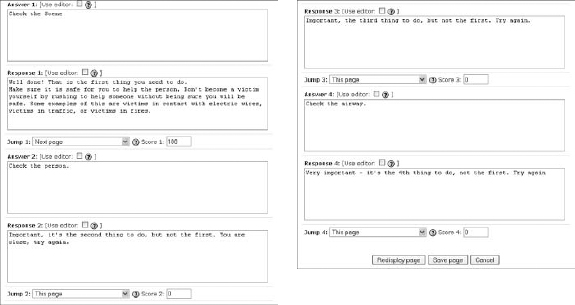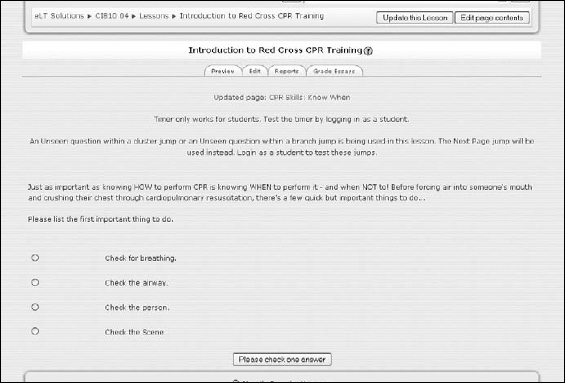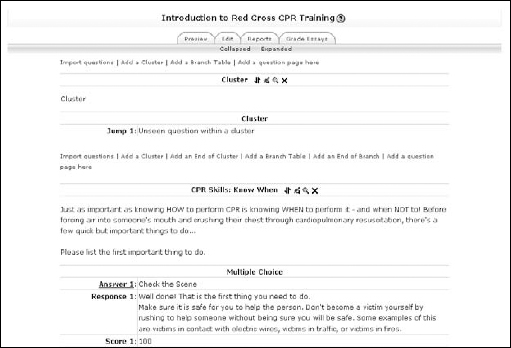Managing and Administering Lessons
After you set up the core structure of the new lesson for your learners, you can start populating it with content and questions. It isn't as difficult as you may think, but because it's an activity enabling you to create instruction and assessment, it's more time-consuming than some of the other activities — but well worth it!
Checking out a lesson page
After you first create a new lesson, click the lesson icon on the course front page, and Moodle takes you to a How to Add Lessons to Your Class page, with the Edit tab open. (See Figure 9-15.) Here you have four options:
- Import Questions: Allows you to import from different formats such as Microsoft Word, Hot Potatoes, Blackboard, and Examview, creating a question for each.
- Import PowerPoint: Slides from a presentation are imported as branch tables, including previous and next answers.
- Add a Branch Table: Creating a branch table provides your learners with a method of moving through pre-order pages where you create branches or paths. The main difference between branch pages and question pages is that branch pages enable learners to choose their own paths through the information. They don't receive page responses, and moving through the lesson doesn't impact their grade. If you want students to move through the information in a specified order, there's no reason for you to use branch table lessons; instead use the question page.
- Add a Question Page: Question pages are similar to branch pages but with more exciting functionality. Your learners see content, which is followed up by a response. Answering the question makes Moodle respond with a response and a Continue button that takes them to the appropriate page. You can use question pages for assessment, and the results will show in the learners' grade book.
Figure 9-15: An editing page for a newly created lesson.

![]() If this is the first time you're creating a lesson, I recommend you start with a question page.
If this is the first time you're creating a lesson, I recommend you start with a question page.
Creating a question page lesson
Question page lessons are ideal for delivering content and a follow-up question or response, ensuring that your learners are assimilating and understanding the content.
To begin, click the Add a Question Page link from the editing page shown earlier in Figure 9-15. It's the last link under Moodle's question, “What would you like to do first?” Moodle takes you to a new Add a Question page (see Figure 9-16), showing six tabs, one for each question type — multiple choice, true/false, short answer, numerical, matching, and essay.
Figure 9-16: Choose the type of question you'd like to add.

- The Multiple Choice tab should be opened. If not, click the Multiple Choice tab.
- Select the Multianswer check box if your multiple-choice questions require students to choose more than one answer.
- Fill in the Page Title field.
Giving the page a descriptive title is useful for you and your learners. You can organize your questions by titles. Your learners can see the title after completing the lesson.
- In the Page Contents field, add the page content including your first question.
 If you're creating a flashcard, entering a question is all you need to do in this part.
If you're creating a flashcard, entering a question is all you need to do in this part. - In the Answer 1 box, enter a possible answer to the question, as shown in Figure 9-17.
Figure 9-17: Entering answer choices and responses.

- In the Response 1 box, enter a response for the answer.
In my example, it's useful to place the first answer as the correct one, so I entered Well done! and then gave further explanation. Moodle shuffles the questions and answers every time it displays them to learners.
- (Optional) Select an option from the Jump 1 drop-down list, which determines what page the learner sees next.
By default, for the Jump 1 drop-down list, Moodle takes the learner to the next page and question. This jump assumes that the first answer was the correct one. You can change the setting to take learners elsewhere if they make an error.
By default the Jump 2–4 drop-down lists have Next Page selected, assuming answers 2–4 are incorrect.
- Enter the score for the answer in the Score field.
- Continue to fill in the following Answer boxes, Response boxes, Jump drop-down lists, and Score fields.
 This may sound silly, but be sure you create a correct answer.
This may sound silly, but be sure you create a correct answer. - When you finish, click the Add a Question Page button at the bottom to go to a new lesson construction page.
The four tabs shown in Figure 9-18 allow you to manage your lesson.
- • Preview: Selecting this tab enables you to view the questions.
- • Edit: Shown in Figure 9-19, this is your main workspace. Notice right under the Edit tab, two links: Collapsed View and Expanded View. Collapsed View shows your questions in a table format, allowing you to edit the question, and it has a drop-down list for action functionality.
The Expanded view (shown in Figure 9-20) shows details of the question and offers a number of further options:
Import Questions: Allows you to import questions from your computer's hard drive without having to go back to the main page.
Add a Cluster: You can add specific questions to a cluster, and Moodle randomly chooses the questions. You may find this useful if you want different questions to pop up for different students. Selecting the Random Question within a Cluster option, from the Start Cluster menu enables most options.
Figure 9-18: Lesson construction pages with your first question.

Figure 9-19: Your main workspace.

Figure 9-20: Additional editing options.

Add an End of a Cluster: One cluster question has to be designated as an end of a cluster, acting as a jumping point to direct learners to more questions or information pages.
Add an End of Branch: If you're using branching pages and tables, you should end each branch with an end page, which directs learners to the last branch table so they can choose another branch or activity.
- • Reports: Click this tab to see an overview or a detailed report of individual learners' activity within the lesson. The overview is the default setting.
- • Grade Essays: Clicking this tab leads you to options to grade essay questions. If you didn't set essay questions in the lesson, nothing is displayed under the tab.
The lesson module has many more cool features, functionality, and options such as creating flashcards. Because I don't want to scare you off with too many pages, I offer more instructions with accompanying examples on this book's companion Web site at www.dummies.com/go/moodlefd.
Go on. Start planning your first lesson and have fun. Your learners will think you're the coolest instructor!
